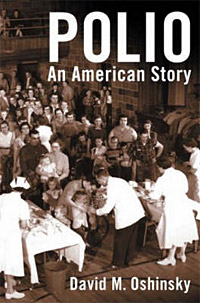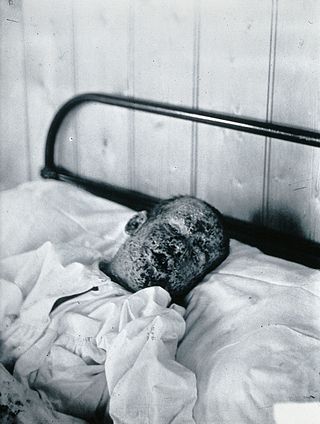
Poliomyelitis, commonly shortened to polio, is an infectious disease caused by the poliovirus. Approximately 75% of cases are asymptomatic; mild symptoms which can occur include sore throat and fever; in a proportion of cases more severe symptoms develop such as headache, neck stiffness, and paresthesia. These symptoms usually pass within one or two weeks. A less common symptom is permanent paralysis, and possible death in extreme cases. Years after recovery, post-polio syndrome may occur, with a slow development of muscle weakness similar to that which the person had during the initial infection.

Polio vaccines are vaccines used to prevent poliomyelitis (polio). Two types are used: an inactivated poliovirus given by injection (IPV) and a weakened poliovirus given by mouth (OPV). The World Health Organization (WHO) recommends all children be fully vaccinated against polio. The two vaccines have eliminated polio from most of the world, and reduced the number of cases reported each year from an estimated 350,000 in 1988 to 33 in 2018.

Rotary International is one of the largest service organizations in the world. The mission of Rotary, as stated on its website, is to "provide service to others, promote integrity, and advance world understanding, goodwill, and peace through [the] fellowship of business, professional, and community leaders". It is a non-political and non-religious organization. Membership is by application or invitation and based on various social factors. There are over 46,000 member clubs worldwide, with a membership of 1.4 million individuals, known as Rotary members.

Poliovirus, the causative agent of polio, is a serotype of the species Enterovirus C, in the family of Picornaviridae. There are three poliovirus serotypes: types 1, 2, and 3.
The oral polio vaccine (OPV) AIDS hypothesis is a now-discredited hypothesis that the AIDS pandemic originated from live polio vaccines prepared in chimpanzee tissue cultures, accidentally contaminated with simian immunodeficiency virus and then administered to up to one million Africans between 1957 and 1960 in experimental mass vaccination campaigns.

Albert Bruce Sabin was a Polish-American medical researcher, best known for developing the oral polio vaccine, which has played a key role in nearly eradicating the disease. In 1969–72, he served as the president of the Weizmann Institute of Science in Israel.

Pulse Polio is an immunisation campaign established by the government of India to eliminate poliomyelitis (polio) in India by vaccinating all children under the age of five years against the polio virus. The project fights polio through a large-scale, pulse vaccination programme and monitoring for poliomyelitis cases.

Polio: An American Story by David M. Oshinsky, professor of history at the University of Texas at Austin, documents the polio epidemic in the United States during the 1940s and 1950s and the race to develop a vaccine, which led to 2 different types of polio vaccine: inactivated poliovirus vaccine, developed by a team led by Jonas Salk, and oral poliovirus vaccine, developed by a team led by Albert Sabin. Published in 2005 by the Oxford University Press, it won the 2006 Pulitzer Prize for History and the 2005 Herbert Hoover Book Award.

Polio eradication, the permanent global cessation of circulation of the poliovirus and hence elimination of the poliomyelitis (polio) it causes, is the aim of a multinational public health effort begun in 1988, led by the World Health Organization (WHO), the United Nations Children's Fund (UNICEF) and the Rotary Foundation. These organizations, along with the U.S. Centers for Disease Control and Prevention (CDC) and The Gates Foundation, have spearheaded the campaign through the Global Polio Eradication Initiative (GPEI). Successful eradication of infectious diseases has been achieved twice before, with smallpox in humans and rinderpest in ruminants.

The history of polio (poliomyelitis) infections began during prehistory. Although major polio epidemics were unknown before the 20th century, the disease has caused paralysis and death for much of human history. Over millennia, polio survived quietly as an endemic pathogen until the 1900s when major epidemics began to occur in Europe. Soon after, widespread epidemics appeared in the rest of the world. By 1910, frequent epidemics became regular events throughout the developed world primarily in cities during the summer months. At its peak in the 1940s and 1950s, polio would paralyze or kill over half a million people worldwide every year.
Mass vaccination is a public policy effort to vaccinate a large number of people, possibly the entire population of the world or of a country or region, within a short period of time. This policy may be directed during a pandemic, when there is a localized outbreak or scare of a disease for which a vaccine exists, or when a new vaccine is invented.

The eradication of infectious diseases is the reduction of the prevalence of an infectious disease in the global host population to zero.
Mikhail Petrovich Chumakov was a Soviet microbiologist and virologist most famous for conducting pivotal large-scale clinical trials that led to licensing of the Oral Polio Vaccine (OPV) developed by Albert B. Sabin.

The Rotary Foundation is a non-profit corporation that supports the efforts of Rotary International to achieve world understanding and peace through international humanitarian, educational, and cultural exchange programs. It is supported solely by voluntary contributions.

Muhammad Ali Pate is a Nigerian physician and politician who is the current Minister of Health and Social Welfare of Nigeria since 2023. He's also a professor of the Practice of Public Health Leadership in the Department of Global Health and Population at Harvard University. He formerly served as the Global Director for Health, Nutrition and Population and director of the Global Financing Facility for Women, Children and Adolescents (GFF) at the World Bank Group. Pate is also the former Minister of State for Health in Nigeria.
Pakistan is one of the two remaining countries in the world where poliomyelitis (polio) is still categorized as an endemic viral infection, the other one being Afghanistan. As of the March 2023, there has been 1 documented case in Pakistan. There were 20 documented cases in Pakistan in 2022, 1 in 2021, and 84 in 2020. The total count of wild poliovirus cases in Pakistan in 2019 was 147.
India National PolioPlus Society is a non-profit organization. The Initiative has achieved significant progress toward its goals. There has been a dramatic decline in cases everywhere in the seventeen years since the target was set in 1988.

The Global Polio Eradication Initiative is an initiative created in 1988, just after the World Health Assembly resolved to eradicate the disease poliomyelitis. Led by the World Health Organization, it is the largest international public health initiative in history.
DTaP-IPV-HepB vaccine is a combination vaccine whose generic name is diphtheria and tetanus toxoids and acellular pertussis adsorbed, hepatitis B (recombinant) and inactivated polio vaccine or DTaP-IPV-Hep B. It protects against the infectious diseases diphtheria, tetanus, pertussis, poliomyelitis, and hepatitis B.
The World Health Organization (WHO) created the Global Commission for the Certification of the Eradication of Poliomyelitis in 1995 to independently verify the eradication of wild poliovirus. The GCC certified the worldwide eradication of indigenous wild poliovirus type 2 on 20 September 2015, and wild poliovirus type 3 on 17 October 2019. In addition, five of the six World Health Organization Regions certified their status as free of indigenous transmission of all three serotypes of wild poliovirus :












